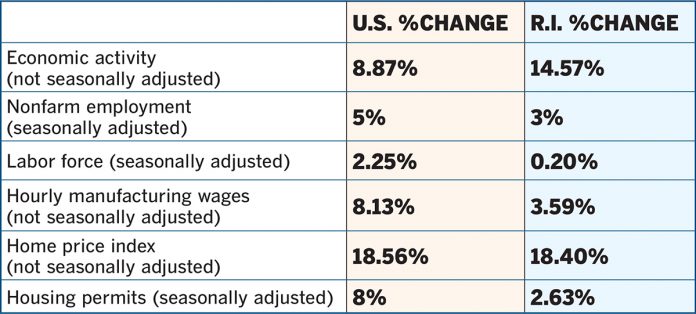Now in her fourth year as the state’s chief executive, Gov. Gina M. Raimondo is looking at running for re-election. So it seems as good a time as any to look at some indicators of the state’s health to begin to assess her time in office.
One metric, created by the Federal Reserve Bank of Philadelphia, is economic activity. The index for Rhode Island has shown significant growth compared with the national average over Raimondo’s first three years in office (starting with January 2015 and ending in December 2017), with growth of 14.57 percent compared with the national growth rate of 8.87 percent.
Drilling down from overall economic activity yields a less-rosy picture, however. For instance, while the seasonally adjusted figures for nonfarm employment and labor force both have increased in Raimondo’s first three years in office – by 3 percent and 0.2 percent respectively – they both lag the national increase. Nonfarm employment across the United States grew 5 percent from the beginning of 2015 to the end of 2017, while the national labor force posted 2.25 percent growth in that period.
And while it is dangerous to draw too many conclusions, it would seem that the increase in economic activity has not had a broad, accelerating effect on the labor market in Rhode Island. For instance, the average hourly manufacturing wage in the Ocean State saw a 3.59 percent growth rate over the three-year period, but that was less than half the 8.13 percent growth seen across the nation.
Home prices, based on an index calculated by the Federal Housing Finance Agency, grew 18.40 percent from the beginning of 2015 to the end of 2017 in Rhode Island. Across the U.S., they grew 18.56 percent. And while housing permits in Rhode Island have increased 2.63 percent, they have gone up 8 percent in the nation.
One caveat with using the data that is available is the fact that many of the governor’s signature economic-development programs, from the Real Jobs Rhode Island job-training program to Rebuild Rhode Island tax credits, were not in place for her full time in office, and to a large degree, their effectiveness is difficult to judge so far. But using the most up-to-date information is the best way, no matter how imperfect, to measure her job performance.













